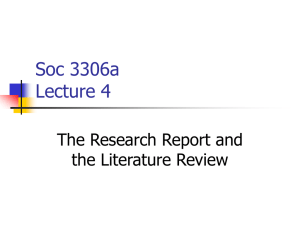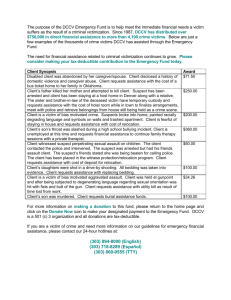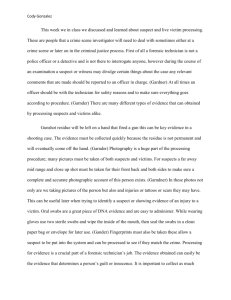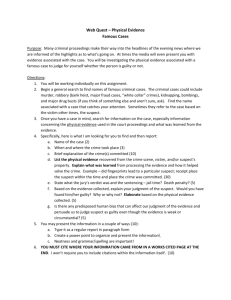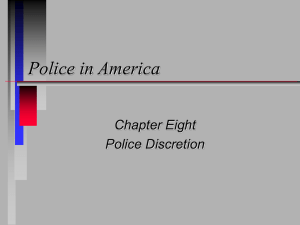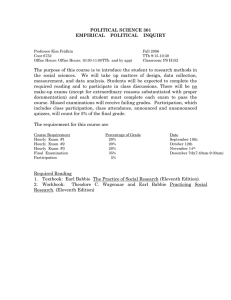here
advertisement
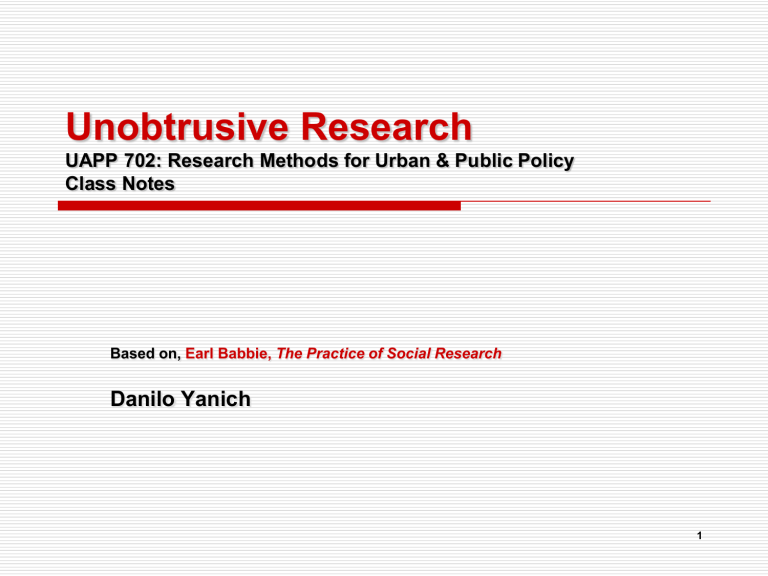
Unobtrusive Research UAPP 702: Research Methods for Urban & Public Policy Class Notes Based on, Earl Babbie, The Practice of Social Research Danilo Yanich 1 Unobtrusive Research Clues all around...must use some ingenuity to examine them... Babbie uses examples of worn tiles in museum, mucus on window, radio dial settings May have some problems with validity and reliability... But that can be accommodated 2 Three types of unobtrusive research Content analysis Analysis of existing statistics Historical/comparative analysis 3 Content Analysis Study of recorded human communications Record the content of those communications Two types of content Manifest Latent 4 Manifest content The visible, surface content of a communication Analogous to a questionnaire with extent of specificity Advantage of reliability, but may have some question of validity Babbie’s example of erotic novel—can count number of times words like love, kiss, etc. are used in book...but Is that a valid measure of eroticism? 5 Latent content The underlying meaning of the content Questions about reliability Babbie’s example re: erotic novel Read entire novel and assess how erotic it is Might be very different assessments by different coders/readers Might even be different assessment if one person was the ONLY reader because no guarantee that definitions will remain same 6 Content analysis Local TV news example, content coding Research question A comparison of the reporting of adult vs. juvenile crime on local TV news stories in the Baltimore and Philadelphia markets By offenses By the characteristics of the suspects and victims By the production modes of the story NOTE: Juvenile crime story=story in which suspect or victim or both are under 18 years of age 7 Content analysis Local TV news example, content coding, p. 2 Sample The videotaped broadcasts of a “constructed” week of the primary evening news broadcast… During March and April 1991, 1992, 1993 and 1996… For all stations delivering a regularly scheduled news broadcast to the market Result: 153 broadcasts from 11 stations 8 Content analysis Local TV news example, content coding, p. 3 Unit of analysis Individual news story Result: 2400 total stories excluding sports and weather Over 700 crime stories 9 Coding instructions for local news ID# Continuous Channel Continuous Date Continuous Story line Continuous Time Duration in seconds Type 1=Crime event; 2=Police; 3=Courts; 4=Corrections; 5=CJ policy Age suspect 1=Juvenile (under 18); 2=Adult; 3=Adults & juveniles 8=Unknown/Not reported 9=NA Age victim 1=Juvenile (under 18) 2=Adult; 3=Adults & juveniles 8=Unknown/Not reported 9=NA Source: CJ 0=No; 1=Yes; 9=NA Source: Defense Atty 0=No; 1=Yes; 9=NA Presentation mode 1=Anchor read; 2=VO/Anchor; 3=Live at location 10 A news story in New York City 11 What do we record? Time Type Age Sus Age Vic Source CJ Source DefAtty Mode Teen pleads guilty in man’s death 45 3 1 2 1 1 2 3/11/98 Man arrested for robbery 23 2 2 2 1 0 1 3/12/98 Domestic dispute turns into hostage situation 45 1 2 3 1 9 3 1=Juv 2=Adult 3=Adults &Juv 8=Unk/ NotReport 9=NA 1=Juv 2=Adult 3=Adults &Juv 8=Unk/ NotReport 9=NA 0=No 1=Yes 9=NA 0=No 1=Yes 9=NA ID# Chan Date 4687 WABC 3/11/98 4688 WABC 4689 WNBC Story Line Seconds 1=Crime event 2=Police 3=Courts 4=Corrections 5=CJ policy 1=Anchor read 2=VO Anchor 3=Live 12 Content analysis Local TV news example, content coding, p. 4 Careful not to take the position that the content analysis often shows what is common knowledge. Example: Local news and race of victim and suspect More often than not, the race or ethnicity of the victims and suspects is NOT reported on local TV news Then, raises the obvious question—why the common assumption? Other possible explanations—Placement of story? Production factors? Offenses? 13 Table 1: In both markets, the race/ethnicity of the victims and suspects most often was not reported or not known Baltimore Philadelphia Victim % of stories Suspect % of stories Victim % of stories Suspect % of stories Not reported/not known 57 41 54 40 Only Caucasian 22 41 25 29 Only African-American 16 17 16 25 Only Hispanic 0 1 3 5 Mixed race/ethnicity 5 0 1 1 Only Asian 0 0 1 0 Race/Ethnicity of Victim/Suspect Source: Danilo Yanich (1998). Crime, Community & Local TV News, p 49 14 Advantages of content analysis Economy of both time and money Safety—it is easier to redo if there is a problem Permits the study of processes that occur over a long time Content analyst has no effect on subject being studied Reliability You can always recode and recode again to ensure reliability 15 Disadvantages of content analysis Limited to the examination of recorded communications Validity problems 16 Analyzing Existing Statistics Babbie makes distinction between secondary data and existing statistics Secondary data—someone else’s data on which you conduct your own analysis. Existing statistics—data analyses that others have done 17 Analyzing Existing Statistics, p.2 Babbie uses Durkheim’s study of suicide as example Concerned with social conditions that encouraged or discouraged it Developed theory of anomie, “normlessness”—a general sense of social instability 18 Analyzing Existing Statistics, p.3 Problems with validity Two ways to deal with validity questions Logical reasoning: Durkheim “reasoned” that most of the suicides in a predominantly Protestant region would be Protestants Replication: Durkheim replicated his study for countries, regions, etc. 19 Analyzing Existing Statistics, p.4 Problems with reliability Babbie uses crime data for drug arrests Arrests may be organizational or political “events” 20 Sources of Existing Statistics Most obvious and important is: Statistical Abstract of the United States Published by U.S. Department of Commerce Bureau of the Census: www.census.gov Best source of data about the U.S. 21 Historical/Comparative Analysis Examines the development of social forms over time Comparing those social forms across cultures 22 Examples of historical/comparative analysis Marx’s progression of history seen as “class struggle” Sorokin’s notion of societies that cyclically alternate between “ideational” (spiritual & religious factors) and “sensate” (sense experiences) points of view 23 Elements of historical/comparative analysis Usually a qualitative method Researcher must find patterns among details describing the subject matter Often informed by a particular theoretical paradigm 24
